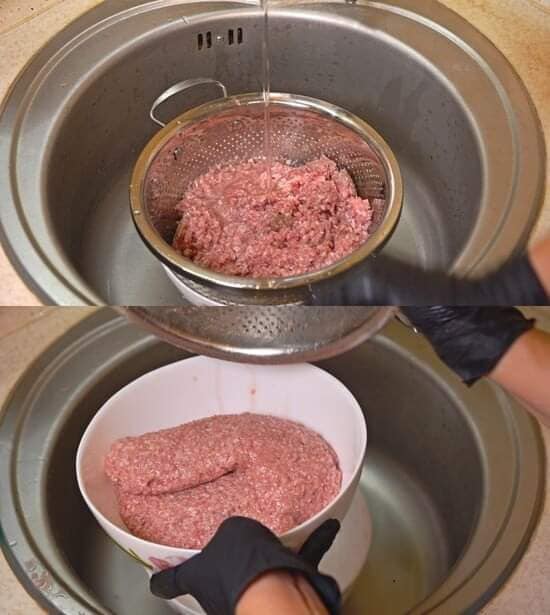ADVERTISEMENT
Why You Should Not Wash Ground Beef
- Water Spreads Bacteria
Washing ground beef can actually cause more harm than good. While rinsing might seem like it would wash away bacteria, water is unlikely to remove harmful pathogens from the surface of the meat. Instead, the splashing water can spread bacteria onto your kitchen sink, countertops, utensils, and other surfaces. This is a serious food safety concern, as cross-contamination can lead to foodborne illnesses. The Centers for Disease Control and Prevention (CDC) and the U.S. Department of Agriculture (USDA) strongly advise against washing raw meat, especially ground beef, for this very reason. - Cooking Kills Bacteria
The primary way to ensure that your ground beef is safe to eat is by cooking it thoroughly. Ground beef should be cooked to an internal temperature of 160°F (71°C), which is high enough to kill harmful bacteria, such as E. coli, Salmonella, and Listeria. These pathogens are typically found on the surface of meat, so as long as you cook it to the correct temperature, you’re safe from foodborne illness. - Loss of Flavor and Texture
Rinsing ground beef can cause some of the natural juices to be washed away, which can negatively impact the flavor and texture of your dish. Ground beef is known for its rich, savory flavor, and washing it removes the fat and moisture that contribute to a juicy, tender result. If you’re aiming for a flavorful and well-textured dish, it’s best to skip the rinse.
The Best Practices for Handling Ground Beef Safely
If washing ground beef is unnecessary and potentially harmful, what’s the best way to handle it safely? Follow these steps to ensure that your ground beef is both safe to cook and delicious to eat:
- Keep Ground Beef Refrigerated
Always store ground beef in the refrigerator until you’re ready to cook it. This helps prevent bacterial growth. If you plan to keep it for more than a day, freeze it to maintain freshness and safety. - Use Proper Hygiene and Avoid Cross-Contamination
While you shouldn’t wash the beef, it’s essential to handle it with care to avoid cross-contamination:
- Wash your hands thoroughly before and after handling raw meat.
- Clean all utensils, cutting boards, and surfaces that come into contact with raw meat with hot, soapy water.
- Use separate cutting boards for raw meat and vegetables to prevent cross-contamination.
- Cook Ground Beef Thoroughly
As mentioned earlier, ground beef should be cooked to a safe internal temperature of 160°F (71°C). Use a food thermometer to ensure that it has reached the right temperature, especially if you’re making dishes like burgers or meatloaf. - Cook Immediately After Handling
Once you’ve taken ground beef out of the refrigerator, it’s best to cook it immediately. If you need to store it for later, return it to the fridge or freezer without letting it sit out at room temperature for too long.
Alternatives to Washing Ground Beef
While washing isn’t necessary, there are a few tips you can follow to ensure your ground beef stays fresh and safe without compromising flavor:
- Searing and Browning Properly:
When cooking ground beef, searing or browning it over medium-high heat can help to lock in moisture and flavor. Use a heavy skillet and avoid overcrowding the pan, as this can lead to uneven cooking. - Draining Excess Fat:
After cooking the ground beef, you may want to drain excess fat from the pan, especially if the recipe calls for leaner meat. This is particularly important when using higher-fat content ground beef. To drain, simply tilt the pan carefully, using a spoon or ladle to scoop the fat into a container to discard. - Use Lean or Extra-Lean Ground Beef:
If you’re concerned about the fat content of ground beef, choose leaner options. Ground sirloin or extra-lean ground beef will have less fat, which can reduce the need for draining and help you achieve a healthier dish without compromising flavor.
Final Thoughts
In conclusion, washing ground beef before cooking is neither necessary nor recommended. Rinsing meat can spread harmful bacteria around your kitchen and isn’t effective in removing pathogens. Instead, focus on handling your ground beef safely, cooking it to the proper internal temperature, and practicing good hygiene to prevent contamination.
By following these best practices, you can enjoy safe, flavorful, and perfectly cooked ground beef without the need for washing. So, the next time you’re preparing a tasty meal with ground beef, skip the rinse and go straight to the cooking process—your family and friends will thank you for it!
ADVERTISEMENT
ADVERTISEMENT
